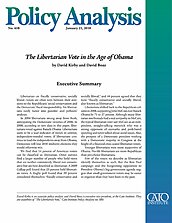In 2004 libertarians swung away from Bush, anticipating the Democratic victories of 2006. In 2008, according to new data in this paper, libertarians voted against Barack Obama. Libertarians seem to be a lead indicator of trends in centrist, independent-minded voters. If libertarians continue to lead the independents away from Obama, Democrats will lose 2010 midterm elections they would otherwise win.
We find that 14 percent of American voters can be classified as libertarian. Other surveys find a larger number of people who hold views that are neither consistently liberal nor conservative but are best described as libertarian. A 2009 Gallup poll found that 23 percent held libertarian views. A Zogby poll found that 59 percent considered themselves “fiscally conservative and socially liberal,” and 44 percent agreed that they were “fiscally conservative and socially liberal, also known as libertarian.”
Libertarians shifted back to the Republican column in 2008, supporting John McCain over Barack Obama by 71 to 27 percent. Although many libertarian intellectuals had a real antipathy to McCain, the typical libertarian voter saw McCain as an independent, straight-talking maverick who was a strong opponent of earmarks and pork-barrel spending and never talked about social issues. Also, the prospect of a Democratic president working with a Democratic majority in Congress at the height of a financial crisis scared libertarian voters.
Younger libertarians were more supportive of Obama. Pro-life libertarians are more Republican than pro-choice libertarians.
Few of the voters we describe as libertarian identify themselves as such. But the Ron Paul campaign and the burgeoning opposition to President Obama’s big-government agenda suggest that small-government voters may be easier to organize than they have been in the past.



